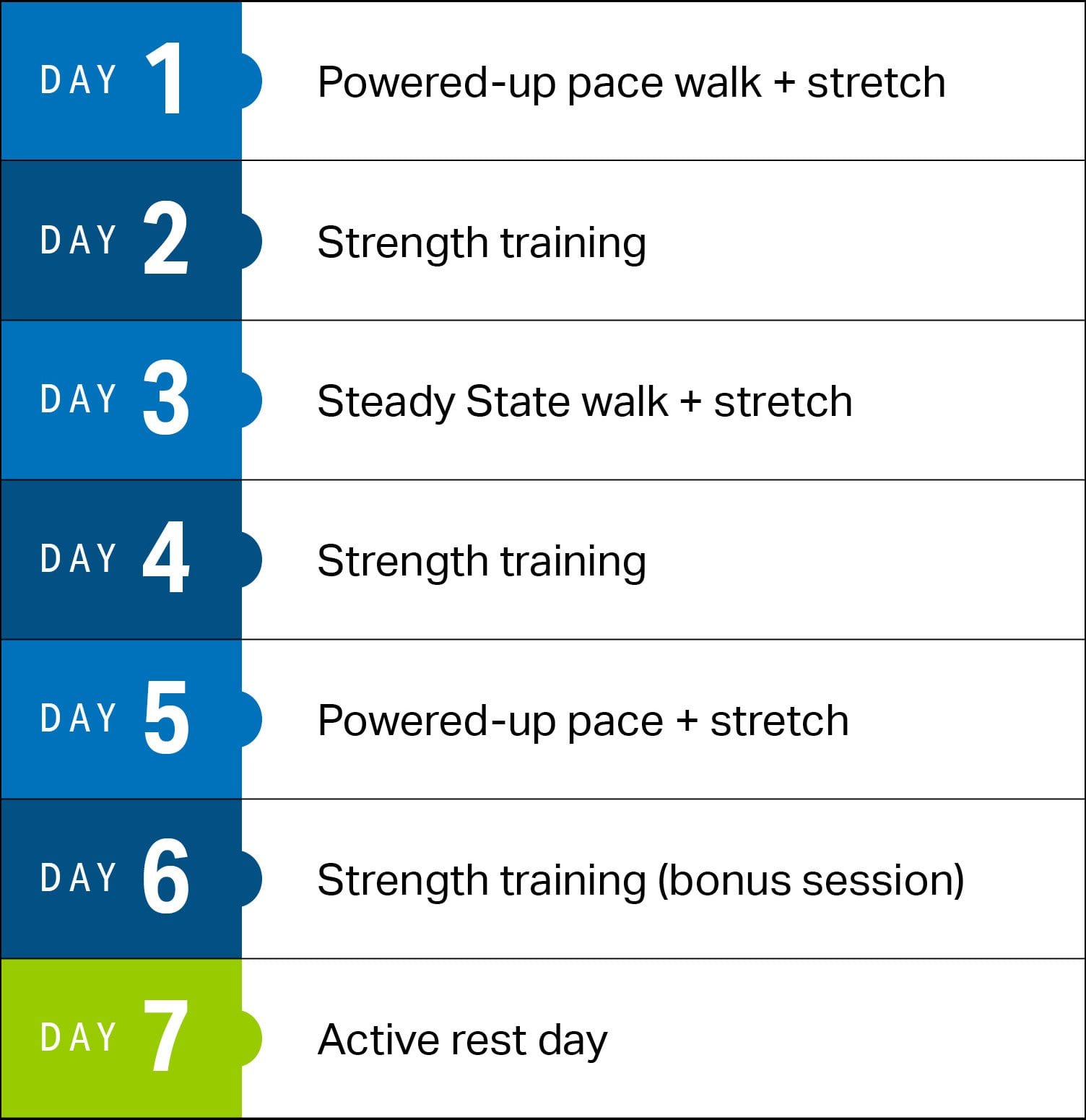
4-Week Power Walking Plan for Weight Loss
If you’re looking to boost your burn during your walks to lose weight faster, it might be time to amp up your walks with power intervals.
Whether you’re just starting out, returning from a long hiatus or are a regular walker, this four-week plan combines steady-state and powered-up pace interval walks along with resistance and flexibility training to help maximize your results.
If weight loss is one of your goals, pairing a regular exercise plan (like this one) with calorie counting might be an effective strategy. While you can lose weight by reducing calories alone, research shows that combining dietary changes with exercise can speed up your results. As Trinh Le, MPH, RD recommends, pairing an 1,800-calorie diet with 300 extra calories burned each day through exercise can be the better choice for weight loss.
To help you put it all together, we’ve created this powered up, five-day-a-week plan designed to help you burn approximately 300 calories a day through exercise. (Please note: Calorie burn is a general estimate, this number will vary greatly by individual, body composition, effort level, etc. For a more accurate reading, a heart rate monitor or other tracking device may be helpful.) On the weekends, you can add a session and/or find ways to move more (such as gardening, cycling, rollerblading, playing with the kids, etc).
While this is a walking plan, we recommend including additional strength and flexibility sessions to boost the body shaping and weight-loss benefits of this plan and help prevent aches and pains.

YOUR WEEKLY GOAL
With this plan, you’ll aim to burn an average of 300 calories per day, with a combination of walking, strength training and stretching. General recommendations are walking three days/week, strength training for 2–3 days/week and flexibility training two days/week (or more), but should be adjusted to meet your current fitness level and schedule. Do this cycle four times and notice how much stronger you get each week.
FOR INTENSITY: POWERED-UP PACE WALK (30–40 MINUTES)
Begin at an easy pace with a 5-minute walk to warm up your body, then use this 2-2-1 interval structure to power up your pace for 20–30 minutes.
- 2 minutes: Walk at a brisk, but steady, pace (intensity: 5 out of 10*; you should be able to talk but your breathing will be quick).
- 2 minutes: Move at a brisk, but steady, pace (intensity: 7/10; you should be able to answer short, brief questions, not carry on a full conversation).
- 1 minute: Power up your pace as fast as you can, pumping your arms quickly to propel you faster (intensity: 8/10; this should feel very difficult, but manageable for 60 seconds).
Repeat the entire series of 5-minute intervals 4 times for a 30-minute walk and 6 times for a 40-minute walk (totals leave time for a 5-minute warmup and 5-minute cooldown).
Adding bursts of intensity like this during your walk is a great way to burn more fat in less time, without having to add the impact of jogging or running. Wind down your walk with a cooldown of about 5 minutes at an easy pace to recover your breathing and heart rate (you may also want to end your walk with these simple, total body stretches).
FOR ENDURANCE: STEADY STATE WALK (40–50 MINUTES)
Begin with an easy pace, 5-minute walk to warm up your body, then maintain a brisk, but steady, walking pace (intensity level 5–6) for 30–40 minutes. Cooldown for about 5 minutes, moving at an easy pace to recover your breathing and heart rate (you may also want to end your walk with simple, total-body stretches).
STRENGTH TRAINING (20–30 MINUTES)
Perform total body, strength-building movements using your bodyweight, dumbbells, resistance bands or whatever equipment you prefer.
STRETCHING (3–15 MINUTES)
Stretching can be done after your walks if it’s convenient for you, or at another time of your choosing. Focus on stretching your entire body evenly, paying extra attention and spending more time with areas that may be tight or stiff (for more stretching tips click here).
ACTIVE REST DAY
Stretch, garden, take a leisurely bike ride or stroll around the neighborhood. The point is to take a day off of “exercise” but you can still stay in motion while you ‘rest’ your body!
*Intensity scale of 1–10 refers to 10 being absolute maximal effort and 1 being no effort at all.
TIPS
Depending on your starting point, you’ll want to adapt the plan to meet your current fitness level and schedule. If you are just beginning to exercise, you may need to reduce your days per week and/or the length of your daily sessions. Each week, you can add 1 day of training or extend your session by 5 minutes to progressively increase your workload without overdoing it. Tailor it to meet your needs and preferences so it’s easy to stick with and that you can stay consistent with the plan because consistency is the key to getting (and maintaining) results!
Remember, while you might not burn as many calories during a strength-training session, by adding more muscle to your frame, you are adding more metabolically active tissue to your body (muscle tissue burns more calories at rest than fat). Don’t sweat it if you fall short of your 300-calorie goal on strength days — you are making important changes to your body with resistance training that will help change your body composition and shape over the long term.
TELL US YOU’RE IN!
Are you going to join us for this plan? Leave a comment below, and let us know. We’re here to support each other and be accountable. We’re in this together team!

































